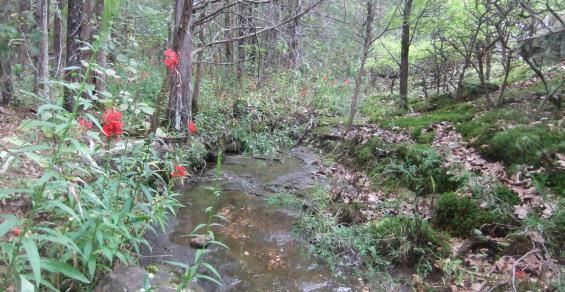Grow Native: Trees and vines shore up streambanks and offer wildlife habitat.
Do you ever think about plants that grow in out-of-the-way places, such as in the creek on your farm? Typically, they are out of sight and out of mind.
Many think of them as mere drainage ditches, standing ready to take on the next big rain. To some degree, they are. When I’m looking over the backyard to the wall of trees at the edge of the creek, I see a tangle of trees, vines, cattails and willows. It’s difficult to see past the edge because there is such a thicket.
You might call these plants weeds (we each have different ideas about what a weed is), but in this instance, I think of them as plants with purpose.
Growing your creek bank
Take inventory of what lines your creek. Here are a few you might recognize, along with why they are so important:
Trees. Willows slow water, secure creek banks and are food host plants for butterfly and moth species, which are fed to baby birds in the nest.
Berry-producing vines. Grape, Virginia creeper and poison ivy feed adult birds who need to fatten up for winter.
Cattails. These grow densely in standing water, prevent erosion, filter pollutants and support aquatic insect species such as dragonflies.
All of these plants typically got their starts from seeds flown in on the wind or from a bird or floated from upstream. Nobody planted them, still they prevent streambank erosion. In many cases, they are often the greatest source of wildlife diversity on your farm.
Protect your waterway
Creek corridors are ground zero for wildlife survival. They are breeding grounds, nurseries and the epicenters of wildlife. Increasing native plant diversity helps.
Tree leaves need to fall to the ground to support overwintering luna moth cocoons. Gravel beds need to ripple clean water, to support minnows and herons.
Still pools of water need rotting leaves and algae to feed tadpoles, salamanders and dragonfly larvae — and their predators. Dead trees need to stand, to be homes for owls and woodpeckers. And they need to fall to become food for beetles and fungi. Willows need to thrive, to feed moth caterpillars that feed baby birds. All of this is happening now in a natural creek near you.
Get out, explore and appreciate the creeks that literally flow through your farms.
Woodbury was the horticulturist at Shaw Nature Reserve for 30 years and continues contract work on native landscaping education. He operates Cacalia: Native Garden Design and Wilding.




